This month sees the following articles in Dalton Transactions that are in the top ten most accessed:-
Synthesis and bio-functionalization of magnetic nanoparticles for medical diagnosis and treatment
Thomas D. Schladt, Kerstin Schneider, Hansjörg Schild and Wolfgang Tremel
Dalton Trans., 2011, 40, 6315-6343 DOI: 10.1039/C0DT00689K
From molecules to materials: Molecular paddle-wheel synthons of macromolecules, cage compounds and metal–organic frameworks
Mathias Köberl, Mirza Cokoja, Wolfgang A. Herrmann and Fritz E. Kühn
Dalton Trans., 2011, 40, 6834-6859 DOI: 10.1039/C0DT01722A
Artificial photosynthesis: semiconductor photocatalytic fixation of CO2 to afford higher organic compounds
Michael R. Hoffmann, John A. Moss and Marc M. Baum
Dalton Trans., 2011, 40, 5151-5158 DOI: 10.1039/C0DT01777A
The first porous MOF with photoswitchable linker molecules
Antje Modrow, Dordaneh Zargarani, Rainer Herges and Norbert Stock
Dalton Trans., 2011, 40, 4217-4222 DOI: 10.1039/C0DT01629B
Organometallic frustrated Lewis pair chemistry
Gerhard Erker
Dalton Trans., 2011, 40, 7475-7483 DOI: 10.1039/C1DT10152H
Laboratory-based separation techniques for insoluble compound mixtures: methods for the purification of metal–organic framework materials
Tony D. Keene, Daniel J. Price and Cameron J. Kepert
Dalton Trans., 2011, 40, 7122-7126 DOI: 10.1039/C1DT10251F
Contributions of inorganic chemistry to energy research
Duncan Wass and Neil Robertson
Dalton Trans., 2011, 40, 3775-3776 DOI: 10.1039/C1DT90027G
Chemistry and applications of organotin(iv) complexes of Schiff bases
Mala Nath and Pramendra K. Saini
Dalton Trans., 2011, 40, 7077-7121 DOI: 10.1039/C0DT01426E
Delineating similarities and dissimilarities in the use of metal organic frameworks and zeolites as heterogeneous catalysts for organic reactions
Amarajothi Dhakshinamoorthy, Mercedes Alvaro, Avelino Corma and Hermenegildo Garcia
Dalton Trans., 2011, 40, 6344-6360 DOI: 10.1039/C1DT10354G
Effect of NH2 and CF3 functionalization on the hydrogen sorption properties of MOFs
Claudia Zlotea, Delphine Phanon, Matjaz Mazaj, Daniela Heurtaux, Vincent Guillerm, Christian Serre, Patricia Horcajada, Thomas Devic, Emmanuel Magnier, Fermin Cuevas, Gérard Férey, Philip L. Llewellyn and Michel Latroche
Dalton Trans., 2011, 40, 4879-4881 DOI: 10.1039/C1DT10115C
Why not take a look at the articles today and blog your thoughts and comments below.
Fancy submitting an article to Dalton Transactions? Then why not submit to us today or alternatively email us your suggestions.












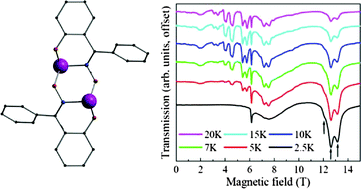 In this HOT Article, the serendipitous self-assembly of the complex [MnIII2ZnII2(Ph-sao)2(Ph-saoH)4(hmp)2], whose magnetic core consists solely of two symmetry equivalent Mn(III) ions linked by two symmetry equivalent –N–O– moieties, provided Brechin and co-workers with a relatively simple model complex with which to study the magneto-structural relationships in more complicated polynuclear oxime-bridged Mn(III) cluster compounds.
In this HOT Article, the serendipitous self-assembly of the complex [MnIII2ZnII2(Ph-sao)2(Ph-saoH)4(hmp)2], whose magnetic core consists solely of two symmetry equivalent Mn(III) ions linked by two symmetry equivalent –N–O– moieties, provided Brechin and co-workers with a relatively simple model complex with which to study the magneto-structural relationships in more complicated polynuclear oxime-bridged Mn(III) cluster compounds.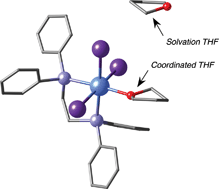 In this HOT article, Díaz-Torres and Alvarez have developed a scale which attempts to quantify the weakly coordinating character of a variety of solvents and anions towards a transition metal or a lanthanide. This was made possible by analyzing crystal structures for the presence of coordinated and uncoordinated groups (solvents or anions) in the presence of a transition metal or a lanthanide and extracting from this coordinating ability indices. These indices should prove very useful in providing general trends allowing comparison between different solvents or anions and should be very useful for the broad organometallic community.
In this HOT article, Díaz-Torres and Alvarez have developed a scale which attempts to quantify the weakly coordinating character of a variety of solvents and anions towards a transition metal or a lanthanide. This was made possible by analyzing crystal structures for the presence of coordinated and uncoordinated groups (solvents or anions) in the presence of a transition metal or a lanthanide and extracting from this coordinating ability indices. These indices should prove very useful in providing general trends allowing comparison between different solvents or anions and should be very useful for the broad organometallic community.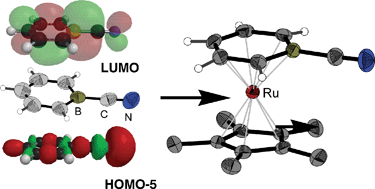 In this HOT article, Cade and Hill describe the synthesis of a salt of the 1-borabenzonitrile anion as its tetrabutylammonium salt and a preliminary exploration of its coordination chemistry in which it behaves as neither a conventional nitrile nor an isonitrile. The authors present computational, spectroscopic and crystallographic evidence for the heterocycle and a ruthenium complex containing the anion as an “arene” ligand.
In this HOT article, Cade and Hill describe the synthesis of a salt of the 1-borabenzonitrile anion as its tetrabutylammonium salt and a preliminary exploration of its coordination chemistry in which it behaves as neither a conventional nitrile nor an isonitrile. The authors present computational, spectroscopic and crystallographic evidence for the heterocycle and a ruthenium complex containing the anion as an “arene” ligand.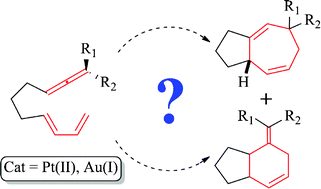 A group of Spanish scientists have investigated the intramolecular [4C+3C] cycloaddition reaction of allenedienes in this Dalton Transactions Hot article.
A group of Spanish scientists have investigated the intramolecular [4C+3C] cycloaddition reaction of allenedienes in this Dalton Transactions Hot article.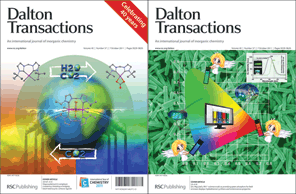 Check out the latest cover artwork for
Check out the latest cover artwork for 

![Molecular structure of [Ni6(O2CPh)6(6-mepao)6]](http://www.rsc.org/ej/DT/2011/c1dt10657k/c1dt10657k-f1.gif) Researchers from the University of Barcelona make discrete polynuclear metal complexes containing nickel in this Dalton Transactions Hot article.
Researchers from the University of Barcelona make discrete polynuclear metal complexes containing nickel in this Dalton Transactions Hot article.